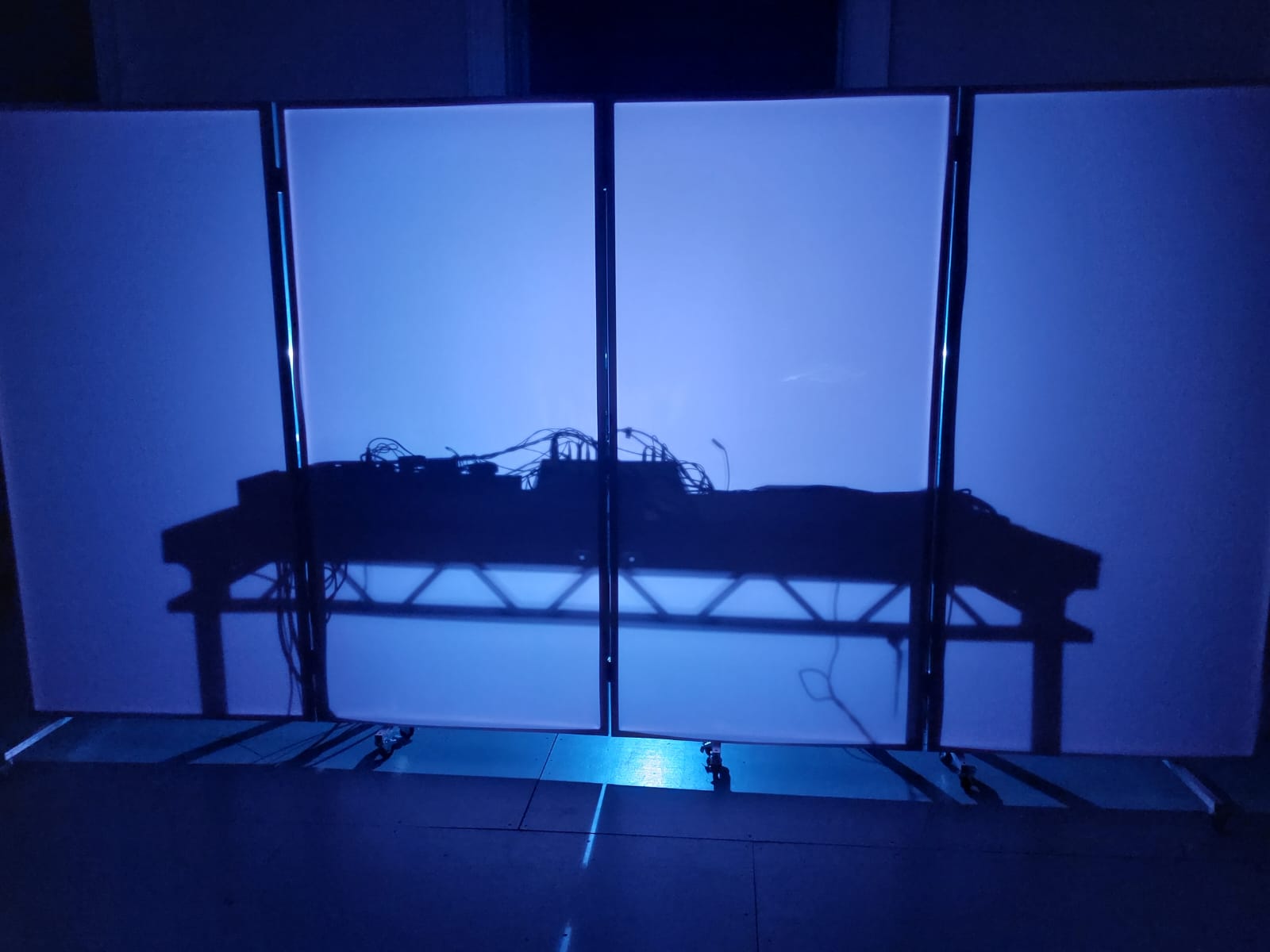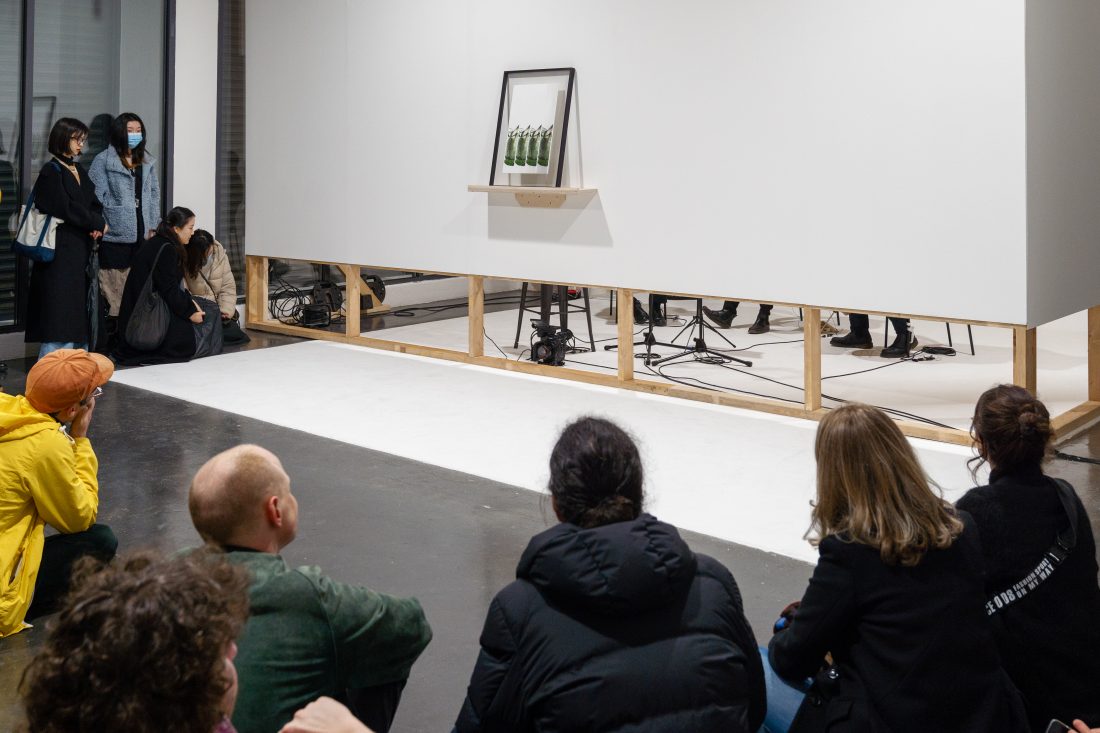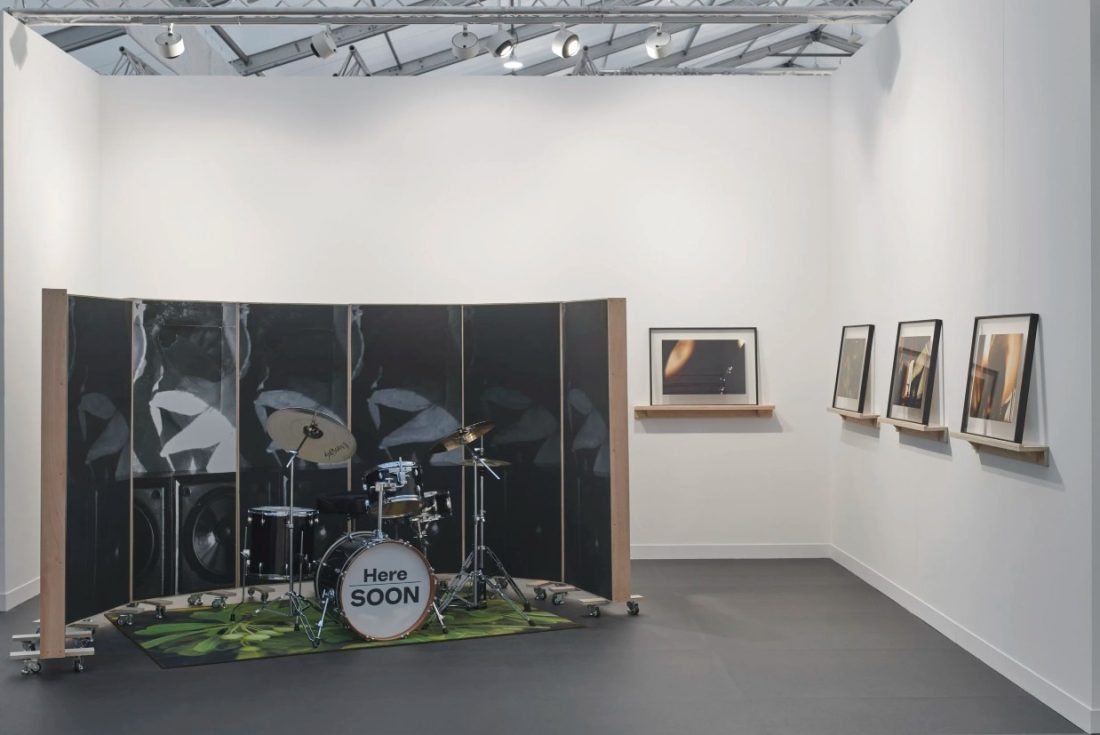
Installation of Dono: Appau Jnr Boakye-Yiadom & Harun Morrison, 2024. Somerset House. Photo: Lily Tonge
Artist Appau Jnr Boakye- Yiadom‘s practice spans sound, photography, installation and video. His multi-layered installation works highlight cultural collision.
Since 2022, he has been working on a series of live events called Compliments. For this series, he has collaborated with musicians for live improvisation, each new piece referencing and sometimes combining outcomes from previous works.
Boakye-Yiadom is the first recipient of the Donna Lynas Residency, a three year partnership between Wysing Arts Centre, South London Gallery, Modern Art Oxford and Somerset House Studios.
Find out more about his practice, what he’s been up to during the residency and his plans for the next live event coming up at the SLG on 18 October 2025.
For those new to your work, tell us a little bit about your practice.
I work with a pluralistic practice, using different mediums. My works find themselves taking the shape of installations, live situations, videos, photographic work, and sometimes ready-made objects.
I had a typical start of going to art school and painting. And at some point, midway through, I started to branch away from that. Painting felt like an entry point. My work became more about ideas than a painting practice, I think. I was loving just coming up with ideas.
Your work has increasingly incorporated durational, live performance and sound. How has that strand of your work evolved?
It started really when I was working with a particular video work 4minute 6 of Conversation 2014. I was researching dance. I was interested in the fact that the human body, although it stays the same, throughout history there have been new moves that come about. But contrary to that is the fact that, because we’ve had the same limbs and everything for however long we’ve been human, you also sort of revisit dance moves. So I was interested in the idea that it’s not really a case of invention, it’s a case of realigning and re-establishing.
When I was using this archive material, I became quite interested in instigating it and so it developed beyond this video piece. I introduced a live drummer, instead of a recorded soundtrack.
Creating live is something that really highlights my own limitations. I work with different sounds and instruments that I can’t necessarily play. So where that highlights my limitation, it highlights that the art is not in isolation, but it is constantly connecting and looking for and finding people to expand in your conversation. And that is just life. For me, I just see that as how most things exist in this world.
How do you approach collaborations with other artists and musicians?
Collaboration is an important part of my practice because it’s a conversation. In most cases, when I’m collaborating with people, they tend to be people I haven’t worked with before. I’m always interested in that idea of how to show my limitations. What makes me grow and makes the work grow, is this mesh of new voices and new things and bringing in a new perspective.
If I don’t know them, I don’t know where they stand with things. So how they interpret things or how they see things, it allows a new fresh perspective to the work. And so this idea of multiple voices only makes the work stronger in some way, for me.
At the South London gallery, you’re going to present a new iteration of the Compliment series. Can you talk us through the ideas behind this latest version? How does it build on your previous performances?
The Compliment series has been in three iterations. The first and second iterations were focused around this image of a vase in the shape of a fish, that had frozen dead fish inside it. With this new iteration, I’m replacing the vase with ice. As the ice melts, the vase then acts as an hourglass, or a timekeeper. The melting or the deterioration or the dissolving of the work marks the length of the performance. So the object itself is performing alongside this sonic work that will be accompanying it.
The first iteration was The Roberts Institute of Art in London in 2022, and that involved a String Trio from Apartment House. And then that audio was taken to Fruitmarket in Edinburgh. On top of the recording of the String Trio, we had Scottish based musicians; Richard Bamford on Drums, Steve Kettley on Saxophone and Flute, James Stewart on Double Bass & George Kypredimos on piano. They were playing to what was the original recording but people in Edinburgh could only hear Edinburgh, not the London recording.
At the SLG, the musician is going to hear those two recordings and will play on top of it all live. They will also be soundtracking the viewers, as they enter the space to view this melting ice sculpture. I’ll be recording the ice melting with a video camera and also recording the sound of the musician and that will hopefully form a moving image work to be shown at a later date.
I’m building on the past. The sonics are quite interesting because if this continued, you have this sense of an orchestra created around this one particular thing over a period of time.

The new work explores ideas of power structures, ownership and control. How do you see your practice connecting with wider cultural or political conversations that people are having?
While researching, I was really thinking about collections in terms of archives and desire. The sort of early 20th century idea around accumulation and the strive to understand everything, especially within a western context and how this filters on how we view things today. museums are constructed so you can easily jump in and attempt to understand culture within certain places in the world.
The flip side of that, is where collections were used as a pigeonholing tool. Being used to try and clarify an idea of some kind, whether that be an idea of eugenics or an idea of “advancement” over the “less advanced”. Research and ideas of knowledge for dominance. I am quite interested in how that has changed over time, how that’s closed so many doors, how that’s been a hindrance. I like this unfolding and discoveries of how perceived truths can be wrong. For example the blanket idea that was once understood of all sea inhabitants being related and called fishes or any other said certainty’s that are constantly re-evaluated for proving to be wrong. I’m thinking about this classification of humans and culture that doesn’t quite add up.
When I’m thinking about making the work, I’m trying to find ways to question those things. I’m interested in people’s interaction with cultural objects and things and probably spend more time in museum and similar spaces, watching people manoeuvre. It’s easy to take things in as facts in these environments and forget about how things have been prioritised or advanced to end up on display.
This sort of categorisation process is set within the control of power.
At the SLG the audience are going to play an active role in shaping the work and the outcome. What does that exchange between the audience and the performer look like?
For the Roberts Institute of Art, the performers were playing in response to the audience, but I don’t think anybody knew that was happening.
There was this wall that the musicians were behind, the wall had a gap at the bottom. Some viewers put their heads to look underneath, but if this happened, I instructed the musicians to stop playing.
I’m still working on this displacement of the performer. At the SLG, they’re going to be obscured in some way, and that’s what I mean about them not physically being there, being somewhere else. So hopefully there’ll be some sort of neutral ground in some way that the viewer and the audience might exist in.

Appau Jnr Boakye-Yiadom. Before, During & After: Here Now, Before, During & After: Here Soon, 2020 – 2024. Courtesy of the artist and Champ Lacombe.
What’s next for you? What are you working on now?
I’m still learning to play the drums, so inserting that into work, as I did in my performance using brush sticks at Frieze in 2024.
I’ve been going back to this idea of collections and what they mean today. Thinking about my own involvement in collecting music. I’ve been collating a range of tracks that reference the same thing and have been experimenting with them sonically, they are currently taking shape in the form of wall texts and T-shirts.
I’ve also been working with Bates Collection instrument archive on a new commission alongside Modern Art Oxford, one of the residency partners.